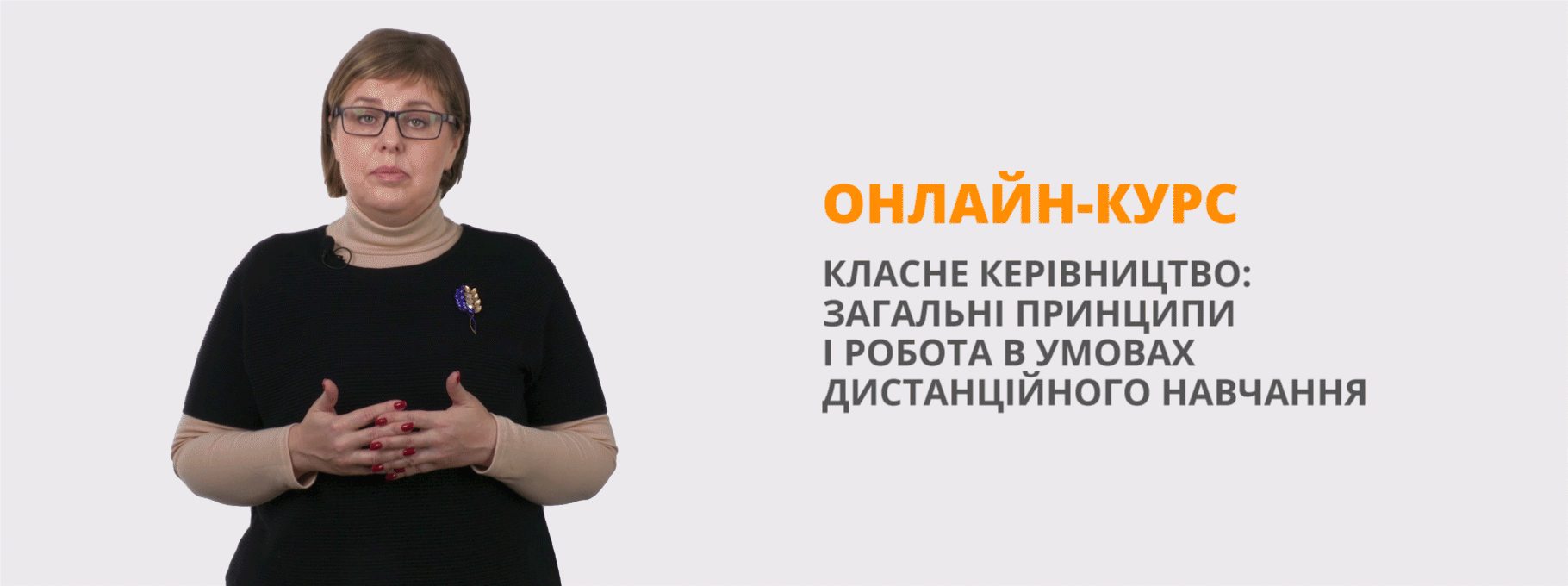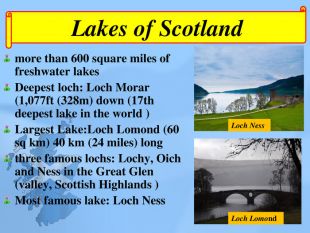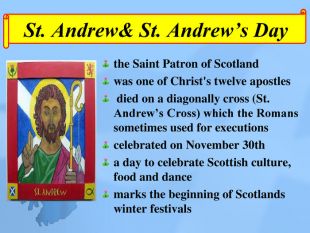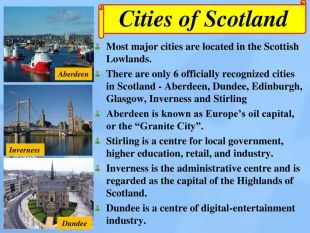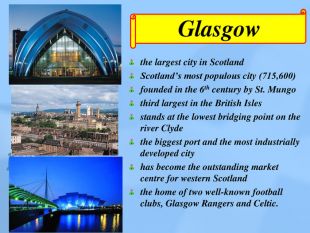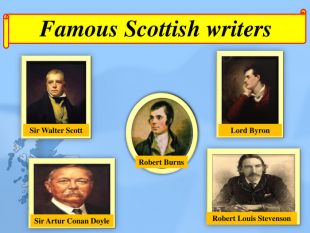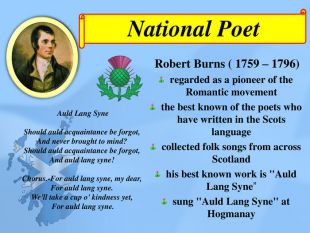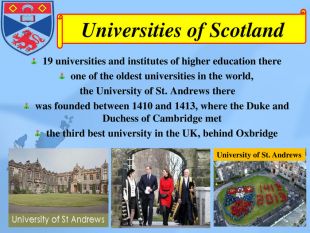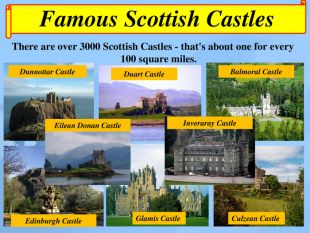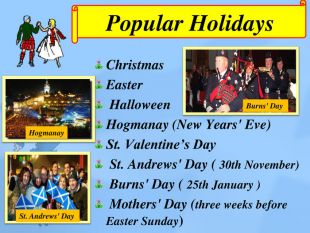Презентація на тему "Scotland: a country in a country" (8 - 11класи)
Доробка представлена у вигляді презентації для учнів 8 - 11 класів та буде надійним помічником для вчителів під час вивчення країнознавчого матеріалу англомовного світу.
































The aim of my work find out more about past and present of Scotlandto get to know more about:the history of Scotlandthe geography of Scotland;its cities and interesting sightsits famous people and inventions;cultural and sports life of Scotland; symbols and holidays of Scotlandexplore differences and similarities between Scotland and another countries of the UK
The country’s name. The name Scotland derives from the Latin Scotia, land of the Scots, a Celtic people from Ireland who settled on the west coast of Great Britain about the 5th century. The name Caledonia has often been applied to Scotland, especially in poetry. The Gaelic name for Scotland is 'Alba‘.
Fact file of Scotland. Area: 30,414 square miles (78,772 km²)Islands: 800 (130 inhabited)Population: 5.2 million, around 8.5 per cent of the UK’s. Queen (of the UK): Queen Elizabeth IIGovernment: Constitutional monarchy. Languages: English, Scots, Scottish Gaelic. Capital: Edinburgh. Official religion: Christianity. National Currency : Pound Stirling (£)Climate: temperate and oceanic
From the history of Scotlandgained independence in 1314, after Robert the Bruce defeated the English army at the Battle of Bannockburn remained as an independent state until 1 May 1707, when the Acts of Union joined it with England, in the United Kingdom of Great Britain Since July 1, 1999, Scotland has its own parliament, for the first time since 1707the people of Scotland voted at the independence referendum on the 18 September 2014 In response to the question, 'Should Scotland be an independent country', (45%) voted Yes and (55%) voted No Scottish Parliament. Robert the Bruce
A country in a countrya sovereign state in the United Kingdomgoverned from Londoneducation system is separate and governed from within Scotlandoil and nuclear energy are governed by the UK Has a lot of independence:has its own legal systemoffers free water for its citizenscontrols its implementation in their greater National Health Servicehas its own judicial system ( courts can come back with a decision of guilty, not guilty, or not proved)has its own police force has its own distinct parliament, which is chaired by the First Minister of Scotland (Nicola Sturgeon). Nicola Sturgeon
Areas of Scotland. The Upper Lowlands lies just north of the UK/Scotland borderan agricultural region has some beautiful rolling hills and greenery. The Central Lowlands the most industrial, urban, and populated region the big urban cities Edinburgh and Glasgow there. The Highlands & Islands covers about 50% of Scotlands' landmasshas the wildest and most dramatic scenery almost 800 (790 to be exact) Scottish islandsonly 130 are still inhabited by man.
Lakes of Scotlandmore than 600 square miles of freshwater lakes. Deepest loch: Loch Morar (1,077ft (328m) down (17th deepest lake in the world )Largest Lake: Loch Lomond (60 sq km) 40 km (24 miles) long three famous lochs: Lochy, Oich and Ness in the Great Glen (valley, Scottish Highlands )Most famous lake: Loch Ness Loch Lomond Loch Ness
Loch Ness & Loch Ness Monsterdeeper than the North Sea very long and very narrow never been known to freeze Some people believe that a large monster lives in it. There are many stories about this water monster Nessie. first recorded appearance of the elusive Loch Ness Monster occurred in 565 AD, when a " water beast " attacked one of St. Columba's followers in the loch. ''
Mountains of Scotland. Three-fourth of the area of Scotland is occupied by mountains. The Highlands contains the country's main mountain ranges. The ten highest mountains in Scotland are also the ten highest in the UK. Ben Nevis 1,344 m (4,409 ft)Ben Macdhui 1,310 m (4,297 ft)Braeriach 1296 m (4,251 ft)Cairn Toul 1291 m (4,235 ft) Sgor an Lochain Uaine 1,258 m (4,127 ft) Cairn Gorm 1,244 m (4.081 ft)Aonach Beag 1,234 m (4,048 ft) Càrn Mòr Dearg 1,220 m (4,002 ft)Aonach Mòr 1,218 m (3,996 ft)Ben Lawers 1,214 m (3,982 ft)Ben Nevis. Ben Lawers Aonach Beag Cairn Toul the highest point
Symbols of Scotland. National emblem: the thistle National flag : the saltire (diagonal white cross on blue background)or St. Andrews Cross. The official animal: the Unicorn. National Motto: 'In My Defens God Me Defend' (or often shortened to read simply 'In Defens') Seen on Scotlands' Royal Coat of Arms. Popular Anthem: 'Flower of Scotland’
St. Andrew& St. Andrew’s Daythe Saint Patron of Scotlandwas one of Christ's twelve apostles died on a diagonally cross (St. Andrew’s Cross) which the Romans sometimes used for executionscelebrated on November 30th a day to celebrate Scottish culture, food and dancemarks the beginning of Scotlands winter festivals
Scotland is famous for… a food made from the organs of sheep and oatmeal a specific woven textile pattern that o often signifies a particular Scottish clan a traditional Scottish woolen cloth costume with a tartan, a skirt that men wear people who play the bagpipes, a traditional Scottish instrument. Haggis. Highland dancing Tartan. Kilt. Bagpipers. Haggis
Cities of Scotland. Most major cities are located in the Scottish Lowlands. There are only 6 officially recognized cities in Scotland - Aberdeen, Dundee, Edinburgh, Glasgow, Inverness and Stirling. Aberdeen is known as Europe’s oil capital, or the “Granite City”. Stirling is a centre for local government, higher education, retail, and industry. Inverness is the administrative centre and is regarded as the capital of the Highlands of Scotland. Dundee is a centre of digital-entertainment industry. Aberdeen. Inverness. Dundee
Edinburghthe inspiring capital of Scotland since the 15th centuryknown as "the Athens of the North“was built on seven hills, like Rome a historic, cosmopolitan and cultured cityone of the United Kingdom's nicest citiesthe second largest city, after Glasgow Europe’s fifth largest financial centerhas more listed buildings than anywhere in the world the most interesting parts of the city (the Old Town and the New Town) the Palace of Holyrood House, the Queen's official residence in Scotland there The Old Town. Calton Hill
Glasgowthe largest city in Scotland. Scotland’s most populous city (715,600) founded in the 6th century by St. Mungothird largest in the British Islesstands at the lowest bridging point on the river Clyde the biggest port and the most industrially developed cityhas become the outstanding market centre for western Scotlandthe home of two well-known football clubs, Glasgow Rangers and Celtic.
Famous Scottish inventions. The method of logarithms (1614) Tarmac (1820) The raincoat ( Charles Macintosh,1824)Telephone( Alexander Graham Bell ,1876 )Pneumatic tyre (1887) Television( John Logie Baird , 1925) Penicillin ( Alexander Fleming, 1928) Radar (Sir Robert Alexander Watson-Watt, during World War II )Alexander Graham Bell Charles Macintosh. Alexander Fleming
National Poet Robert Burns ( 1759 – 1796)regarded as a pioneer of the Romantic movementthe best known of the poets who have written in the Scots languagecollected folk songs from across Scotland his best known work is "Auld Lang Syne”sung "Auld Lang Syne" at Hogmanay. Auld Lang Syne. Should auld acquaintance be forgot, And never brought to mind? Should auld acquaintance be forgot, And auld lang syne! Chorus.-For auld lang syne, my dear, For auld lang syne. We'll take a cup o' kindness yet, For auld lang syne.
Universities of Scotland19 universities and institutes of higher education thereone of the oldest universities in the world, the University of St. Andrews therewas founded between 1410 and 1413, where the Duke and Duchess of Cambridge metthe third best university in the UK, behind Oxbridge. University of St. Andrews
Sport in Scotland. National : Football. The first official international football match was played at the West of Scotland Cricket Club in Partick in 1872, between Scotland and England. Motherland : golf (since 15th century)Traditional: Curling, rugby, shinty. Own Sporting Competitions: the Camanachd Association, the Scottish Rugby Union, Scottish Rugby League Scottish Olympic Games: Highland Games. Highland Games. Shinty. Golf. Football
Highland Gamesoriginate from Ireland in 2000 BC crossed the water to Scotland with the 4th and 5th century migrationsthe largest and most widespread multi-sport festivals of the 19th centuryheld during the whole of the year anywhere in Scotlanda unique mix of sports, culture and communitycomprise a programme of field and track events, piping and Highland dancing competitions and 'heavy events' like the tug-o-war, the hammer throw and tossing the caber
Conclusion of the work one of the most beautiful mountainous countries in the worldofficially a separate country making up part of the UKis not part of an a legal entity such as "England and Wales,“ unlike Wales was a sovereign state until an agreement in 1707 which formed the Kingdom of Great Britain the head of Scotland ( Queen Elizabeth II, the English monarch)In the 1999 devolution process formed: its own Parliament and MPs at Westminsterits distinct legal system from England & Wales or Northern Ireland its own currency (although 1:1 with Sterling, backed by Bank of England and cosmetically different only) Scottish towns differ from the English oneswell-known for its Loch Ness monster, famous poets and inventors, sights and castles, delicious haggis and traditional festivalsa suitable country for students as wellthousands of tourists visit Scotland every year
Information sources http://www.interestingfunfacts.com/amazing-facts-about-scotland.htmlhttp://listverse.com/2014/01/05/10-things-you-should-know-about-scotland/http://www.scotlandinaweek.com/facts-about-scotland.htmlhttp://www.telegraph.co.uk/news/uknews/scotlandhttp://www.britannica.com/place/Scotlandhttp://www.scotlandinaweek.com/scotland-flag.htmlhttp://www.planetware.com/tourist-attractions-/edinburgh-sco-loth-edin.htmhttp://www.touropia.com/tourist-attractions-in-scotland/http://www.visitscotland.com/about/arts-culture/hhttp://www.worldatlas.com/webimage/countrys/europe/scotland/ukssymbols.htmhttps://en.wikipedia.org/wiki/Scotlandhttp://www.scotland.org/
-
 Krupska Viktoria 25.04.2024 в 17:18Загальна:5.0Структурованість5.0Оригінальність викладу5.0Відповідність темі5.0
Krupska Viktoria 25.04.2024 в 17:18Загальна:5.0Структурованість5.0Оригінальність викладу5.0Відповідність темі5.0 -
 Суржан Вікторія 09.04.2023 в 13:21Загальна:5.0Структурованість5.0Оригінальність викладу5.0Відповідність темі5.0
Суржан Вікторія 09.04.2023 в 13:21Загальна:5.0Структурованість5.0Оригінальність викладу5.0Відповідність темі5.0


про публікацію авторської розробки
Додати розробку
